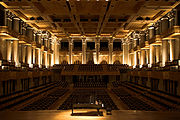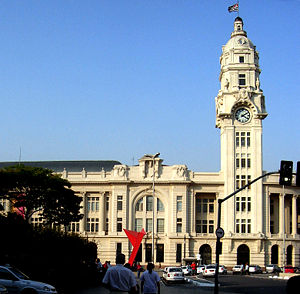
Sala São Paulo
Encyclopedia


City
A city is a relatively large and permanent settlement. Although there is no agreement on how a city is distinguished from a town within general English language meanings, many cities have a particular administrative, legal, or historical status based on local law.For example, in the U.S...
of São Paulo
São Paulo
São Paulo is the largest city in Brazil, the largest city in the southern hemisphere and South America, and the world's seventh largest city by population. The metropolis is anchor to the São Paulo metropolitan area, ranked as the second-most populous metropolitan area in the Americas and among...
, Brazil
Brazil
Brazil , officially the Federative Republic of Brazil , is the largest country in South America. It is the world's fifth largest country, both by geographical area and by population with over 192 million people...
, was inaugurated on July 9, 1999. The building has been totally restored and renovated by the São Paulo State Government, as part of the downtown revitalization in that city. It houses the Sala São Paulo, which has a capacity of 1498 seats and is the home of the São Paulo State Symphonic Orchestra (OSESP). It is a venue for symphonic and chamber presentations and has been designed according to state of the art standards, comparable to the Boston Symphony Hall
Symphony Hall, Boston
Symphony Hall is a concert hall located at 301 Massachusetts Avenue in Boston, Massachusetts. Designed by McKim, Mead and White, it was built in 1900 for the Boston Symphony Orchestra, which continues to make the hall its home. The hall was designated a U.S. National Historic Landmark in 1999...
, Musikverein in Vienna
Vienna
Vienna is the capital and largest city of the Republic of Austria and one of the nine states of Austria. Vienna is Austria's primary city, with a population of about 1.723 million , and is by far the largest city in Austria, as well as its cultural, economic, and political centre...
and the Concertgebouw
Concertgebouw
The Concertgebouw is a concert hall in Amsterdam, Netherlands. The Dutch term "concertgebouw" literally translates into English as "concert building"...
in Amsterdam
Amsterdam
Amsterdam is the largest city and the capital of the Netherlands. The current position of Amsterdam as capital city of the Kingdom of the Netherlands is governed by the constitution of August 24, 1815 and its successors. Amsterdam has a population of 783,364 within city limits, an urban population...
.
Renovation began in November 1997, but the first steps were taken in 1995. Governor Mario Covas visualized the Julio Prestes space as ideal for symphonic presentations and because OSESP did not have a permanent home.
History of the building

From the 1980s on the Companhia de Trens Metropolitanos - CPTM - took over the line, operating only in the metropolitan area and municipalities in the Greater São Paulo region. The name Julio Prestes honors an ex-railwayman who was governor of São Paulo and a presidential candidate to Brazil. The architect who planned JP, Christiano Stockler das Neves, based his project on an eclectic style, described as neo classical Louis XVI which was a reaction to the overornate baroque style. He was also clearly influenced by the old Pennsylvania station in New York, which was demolished to give way to the building of the Madison Square Garden. While it was being built in the 1920s, the Grand Hall, where the concert hall is today, had a small railway in the middle of the construction work. Thus, imported material from Europe could be easily brought in.
In the beginning of the 21st century, engineers working on the transformation of the Grand Hall have also had their difficulties to reconcile today's technology with historical conservation. An old train was replaced with a gigantic 150 ton crane. This was the only way that the massive girders could be lifted around 25 meters, and be transformed into part of the structure that supports the adjustable ceiling over the new hall.
Choice of the Grand Hall as Concert Hall
The station's large hall was chosen because its dimensions are similar to 19th century concert halls, that is, it is shaped in the 'shoebox styleShoebox style (architecture)
In architecture, shoebox style refers to the functionalist style of modern architecture characterised by predominantly rectilinear, orthogonal shapes, with regular horizontal rows of windows or glass walls...
'. Specialists consider them the best for concert halls, as is the case of the halls in Boston, Vienna and Amsterdam.
Sala São Paulo has 22 balconies at mezzanine and first floor levels. They have been placed between large columns and an adjustable ceiling, created by the American company Artec. Its floor space is ten thousand square meters and the ceiling is 24 meters high.
The venue usually receives classic music concerts, but on 15 January 2009 Elton John
Elton John
Sir Elton Hercules John, CBE, Hon DMus is an English rock singer-songwriter, composer, pianist and occasional actor...
played at the main hall, in a private concert for Cruzeiro do Sul Investments Bank.The concert was attended by 1100.
Concert Platform and Main floor Space
The 320 m platform was strategically built to offer total visibility. It has portable risers which allow choir and orchestra to alternate in mid concert, as well as a stage elevator for a piano.The acoustic project was carefully designed to neutralize vibrations caused by the constant movement of trains. For this reason the main hall's 15 centimeter-thick floating floor was built on an immense neoprene
Neoprene
Neoprene or polychloroprene is a family of synthetic rubbers that are produced by polymerization of chloroprene. Neoprene in general has good chemical stability, and maintains flexibility over a wide temperature range...
slab which functions like a massive wedge between two concrete layers lined with Brazilian walnut, ideal material for absorbing noise. The floor was also lowered 1.22 m to respect acoustic requirements and avoid esthetic disfigurement.
In order to complete the hall's "shoe box" shape, the specialists opted for a
150 mm slab, supported by metallic girders protected by the main structure (trusses) surrounded by 3 panels of gypsum board, each one measuring 12.5 mm thick. In addition to this, ante-chambers were built in all the circulation areas and accesses to the concert hall to exclude undesirable noises. The passage to the platforms is also protected with thick glass, and also effectively blocks invasion of noise from the trains.
The main floor has a capacity for 830 seats and 679 seats in the boxes and balconies on the mezzanine and first floor. The metal seats have ivory wood details. The material used, including the placing and the number of seats were all planned to avoid any possible interference with the flow of sound.
Adjustable ceiling
The adjustable ceiling is suspended 25 meters above the main floor. It has 15 panels, each weighing 7.5 tons and are held by 20 cable coils. The panels can be individually controlled, allowing the volume of the hall to be adjusted to between 12 thousand and 28 thousand cubic meters. This ensures that the intensity of any composition has its acoustic concept respected.The panels can be adjusted independently or together, through the use of computers, locks and automatic sensors. Along with the ceiling's flexibility, 26 velvet banners can hang 8 meters down, according to the vibration required. There is an additional advantage which is that this system shows all the original architecture with elements of the new architectural concept added.
Over the ceiling there is a polycarbonate
Polycarbonate
PolycarbonatePhysical PropertiesDensity 1.20–1.22 g/cm3Abbe number 34.0Refractive index 1.584–1.586FlammabilityV0-V2Limiting oxygen index25–27%Water absorption – Equilibrium0.16–0.35%Water absorption – over 24 hours0.1%...
cover with rounded ends, which respects the concept of the building's original project but uses more modern materials. Thermo-acoustic tiles have been instead of copper, and polycarbonate instead of glass. The trellised cover conditions 230 tons of metal structure and sustains the technical floor. It is composed of a reinforced steel deck, supported on a structural steel grid. The floor is attached to the columns to support the electromagnetic equipment for hanging the lining panels, air conditioning equipment and ducts.

